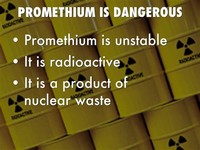Facts about Promethium

The name promethium is derived from Prometheus in Greek mythology, who stole the fire of the sky and gave it to mankind.

Several groups claimed to have produced the element, but they could not confirm their discoveries because of the difficulty of separating promethium from other elements.

Promethium salts luminesce in the dark with a pale blue or greenish glow due to their high radioactivity.

Promethium is an inner transition metal (or lanthanide) that lies in period six of the periodic table, between neodymium and samarium.

In 1963, ion-exchange methods were used at ORNL to prepare about ten grams of promethium from nuclear reactor fuel processing wastes.

Pure promethium exists in two allotropic forms and its chemistry is similar to that of other lanthanides.

Promethium has also been identified in the spectrum of the star HR 465 in Andromeda, and possibly HD 101065 (Przybylski's star) and HD 965.

Promethium (chemical symbol Pm, atomic number 61) is a metallic element that is a member of the lanthanide series of chemical elements.

The isotopes of promethium range in atomic weight from 127.9482600 u (128Pm) to 162.9535200 u (163Pm).

